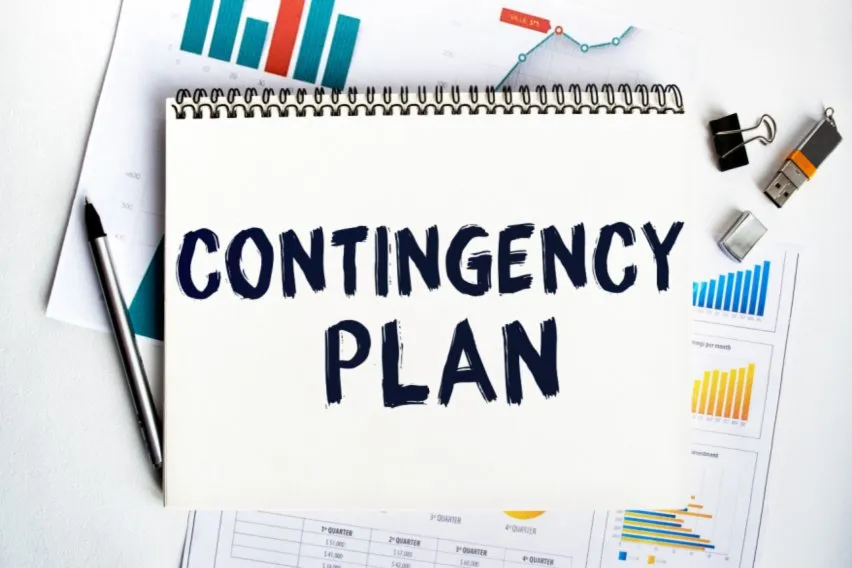Contingency Plan: What It Is and Why Do You Need It?
As much as you won’t want it to happen, sometimes your first plan can go awry. But when that happens, you need a strong backup plan you can quickly put into place.

A proactive strategy helps you manage unfavourable circumstances and guarantee business continuity planning. It allows you to respond to unforeseen occurrences and resume your plans as soon as it’s workable.
But what exactly is a contingency plan? And why is it so important?
Read on as we explain what a contingency plan is, how to create one, and answer some of your questions.
Table of Contents
How to Create a Contingency Plan: 6 Steps
Importance of Contingency Planning
What Is a Contingency Plan?
A contingency plan is a practical plan you must put in place if a foreseeable risk materialises. It serves as a “Plan B” for when things don’t turn out as predicted.
A business contingency plan can reduce risk and help you return to normal operations.
Contingency plans help in responding to natural disasters. Corporations develop them for disaster recovery following floods, earthquakes, or tornadoes.
Backup strategies are crucial for businesses to use when things go wrong. A contingency plan could, for instance, spell out what you’ll do if your chief rivals merge or how you’ll change course if you lose a significant client.
It could even cover less damaging, but impactful situations, such as your office power going out during the workday.

How to Create a Contingency Plan: 6 Steps
The contingency planning process may go something like this:
1. Create a List of Your Integral Processes
What procedures are crucial to your company’s operation and the secure delivery of your goods or service to customers? If you were a tech manufacturer, then your list of processes may include:
- Getting materials from suppliers
- Manufacturing
- Shipping
- Warehousing and packaging
- Distribution
It’s clear to see that there is a lot of potential for risk in this list of processes. And as the company is in the tech industry, the chances are that the material will be expensive to replace.
2. For Each of Your Processes, Create a List of Possible Key Risks
Once you list your processes, think about company continuity. What might impede these vital procedures? What could go wrong?
Take distribution, for example:
- The driver may deliver one or more packages to the incorrect address.
- Delivery mistakes might cause package damage.
- A package could go missing at the distribution facility.
- A package truck might get into an accident.
- A flood could make the local road network unusable.
This step analyses the vulnerabilities and the financial and operational consequences. It considers the impact, severity, and risk of recurrence for the company.
3. Figure Out How Likely Each Risk Is and the Potential Impact
After identifying the risks, it is crucial to determine how they might affect your company.
How likely are they to occur? How much of an influence would they have on your company? Most businesses do this using a risk assessment.
A risk assessment can identify important hazards and address them using response and prevention. This is part of best practice contingency planning.
4. Create Individual Contingency Plans for Your Highest Risks
Make a backup plan for each danger you’ve determined to be significant. Create a brainstorming session with your team to come up with a plan of action in case the danger materialises as part of that contingency plan. Each strategy should outline all the actions you must take to resume regular operations.
Information about the following should be in your contingency plan:
- The unexpected events that will bring about this strategy
- What the immediate response should be
- Who needs to be informed and involved
5. Calculate the Cost of Issues
Now that you have your list of risks, and you know how likely each risk is thanks to your risk assessment, you need to look at the potential costs. What possible financial loss might each risk cause to your company?
There are several ways to do this process. Although it will depend on what sector your business is in and what your processes are. It may be simple, like taking the cost of your at-risk materials and calculating the monetary damage. This allows you to make informed choices when making project plans and annual budgets.
Calculate the expenses of the unfavourable occurrence during the risk analysis.
Doing this means that you can weigh up the cost of preventing the risk vs the risk actually happening. For example, you wouldn’t take out expensive yearly insurance for a product that would be cheap to replace. But you would want to take out insurance on high-priced assets such as machinery.
6. Make People at Your Business Aware of Your Plans
Share your backup plans as soon as you have them written. Make sure everyone is aware of your plan so that you can respond quickly and effectively when the time comes. Keep your backup plans in one location so that, in case of an emergency, everyone can immediately access them.
Create a project on a workflow platform so that everyone has an instruction manual for executing it.
Contingency Plan Examples
Here are two examples of a type of contingency plan:
Natural Disaster Contingency Plan
Despite the rarity of large earthquakes, it could be disastrous if you are unprepared when they hit. This is why backup plans are so important.
But things such as flash floods or electric storms causing a power outage are more common. So it’s important to have a plan in case disaster strikes.
The following could be part of a government earthquake contingency plan:
- The details of the individuals assigned to undertake swift and effective responsibilities.
- Methods for instructing the populace on how to react in the event of an earthquake.
- A schedule for first responders.
Hardware Contingency Plan
It is crucial to ensure the safety and security of your information systems if, for instance, your organisation relies heavily on data. Have an emergency plan in place in case something goes wrong, such as a power surge damaging your servers or a hacker trying to access your network.
A company’s backup plans for a data breach may include:
- Steps to follow to get the data properly secured again.
- Contact details of whom to contact about the implications of the data breach and how to protect their investment.
- A schedule to record the steps being taken to remedy the breach and how to prevent future data breaches.
Importance of Contingency Planning
Having a contingency plan is essential for risk management.
Any contingency plan should help to resume regular business operations as soon as possible in the wake of an unexpected event. A backup plan protects resources, identifies personnel, and designates tasks to help with recovery.
Have a backup plan in place for every department in your organisation. It should address environmental risks, like floods, outages, and leaks. It should also outline obligations for carrying out those tasks in the event of an incident.
Contingency plans give an organisation a framework for evaluating disruptive occurrences. Plus, the steps needed to recover from them. The less harm to the company and its employees, the quicker the recovery is. Maintaining a company’s finances, competitive position, and reputation requires quick recovery.
Key Takeaways
A contingency plan is beneficial if something goes wrong. It identifies potential issues, instructions on what to do in the event of an emergency, and prevention strategies. A proper risk management plan can prepare anyone to handle issues that may arise. This is true even if the person with primary responsibility isn’t present.
Design a strategy for identifying and resolving any problems that may occur. It could be a mitigating factor in the event of prosecution, and failing to have one could lead to a higher fine, as shown by recent convictions.
FAQs on Contingency Plan
What Is a Risk Contingency Plan?
It is a thorough plan for protecting your company from hazards and emergencies from the outside, such as natural disasters.
What Are the Components of a Contingency Plan?
A contingency plan comprises 3 things:
- An analysis of what could occur
- A strategy based on the analysis
- The activities that prepare for the best outcome
What Is the Purpose of a Contingency Plan?
A contingency plan enables a company to resume regular business operations as soon as workable in the wake of an unexpected incident.
What Is a Good Contingency Plan?
A strong contingency plan should include every scenario that could interfere with operations.
RELATED ARTICLES


 Project Initiation: Guide to Kickstart Your Project the Right Way
Project Initiation: Guide to Kickstart Your Project the Right Way Matrix Organisational Structure: Definition, Pros & Cons
Matrix Organisational Structure: Definition, Pros & Cons Risk Register: What It Is and How to Create One
Risk Register: What It Is and How to Create One What Are Profitability Ratios? Definition, Types & Importance
What Are Profitability Ratios? Definition, Types & Importance What Is Compensation Management? Definition & Importance
What Is Compensation Management? Definition & Importance 8 Reasons Why Is Collaboration Important in the Workplace?
8 Reasons Why Is Collaboration Important in the Workplace?